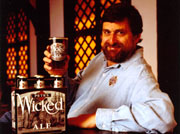Overview
Step up to the bar and have a listen to how Pete’s Brewing Company became one of the most successful speciality brewers in the land with a multi-million dollar business and a firm position in the growing microbrew industry.
A Golden Age and Amber Color
Today’s state of emerging business has been described as “The Golden Age of Small Business.” Small businesses are becoming increasingly competitive against their larger counterparts. The global economy has seen the emergence of new industries that have captured the attention of consumers all over the world, and has allowed resourceful entrepreneurs to capitalize on these markets.

Technology, such as the Internet, personal computers and cellular telephony, have brought a wave of products and services to the consumer. Companies have revitalized markets with their clever product positioning and marketing. Microbrewing ,or specialty brewing, has recently experienced rapid growth in the United States. People have been “home-brewing” beer in their basements and garages for years using simple cooking appliances and ingredients. Certain companies in the U.S. have been specialty brewing for years, but only regionally distributing their beer. Now these darker, more flavorful beers are available to more consumers. The question is: Why haven’t these tantalizing libations been available sooner?
Across America, brew pubs have become a favorite destination of beer drinkers young and old. Some local brew pubs have expanded into regional, and even national restaurant chains. More importantly, some of these specialty brewers have grown into significant players in the U.S. and worldwide beer industry.
Pete’s Brewing Company, makers of Pete’s Wicked Ale specialty beers, is such a player. From one man’s part-time hobby, the company has grown in just about ten years to a publicly-held company. Pete’s Brewing Company had $19MM in sales with 116,400 barrels of beer sold in their 3rd quarter ending September 30, 1996. From their recent annual report, “Pete’s Wicked Ale is a national specialty beer brand that can be found on store shelves in 47 states and in the United Kingdom.” With numerous awards from brewing festivals in Europe and America, Pete’s has become the second largest specialty brewing company in the U.S.
Pete Slosberg and Mark Bronder are the co-founders of Pete’s Brewing Company. Their foresight along with Pete’s knowledge and love of brewing quality beer, combined to create this successful venture. The EM caught up to Pete at his Palo Alto headquarters, in between his hectic travel schedule of lecturing on beer, judging at brewing contests, and writing articles about the brewing industry. We learned about: how Pete first became interested in beer, the founding of Pete’s Brewing company, and the strategies and plans that launched the first commercial operations of Pete’s Wicked Ale.
From Grapes to Grain
“I never drank alcohol growing up. I starting drinking wine when I met my wife.” Pete jokingly refers to this as his early experiences with alcohol, and that it was his wife that drove him to drink. In the 1970s, Pete was working for Xerox in Rochester, New York, one of several corporate financial planning and marketing positions he held during his professional career. He describes one night when a friend invited him to dinner, and served ,according to Pete, an excellent wine. “I asked him who made it, and he said he did. My friend showed me his equipment in the basement and I was amazed a person could make good wine in such a place.” This dinner lead to Pete’s interest in home-made wine. While living on the east coast of the U.S., Pete’s wine making was limited by the lack of space at his home. When he moved to California, he bought a house with a little cellar , and he finally had enough room to make wine.
“What led me from wine to beer was that it was fun to buy the grapes and squeeze them and ferment them, but the Cabernet I started with required you to wait 5 to 10 years for the wine to mature.” He wanted quicker results. He went back to the store that sold him his wine making equipment and ingredients, and they told him he could try a white wine that would be ready in a year or two. They also suggested that if he wanted to try make his own beer that it could be ready in one month. “I liked the idea of beer in a month but I didn’t like beer so I wasn’t looking to do it.” The store owner then said something that really peaked his interest, “Did you ever have a home brew? No I never had. If you haven’t had a home brew you haven’t had a beer.” The store owner told Pete that the equipment he was using for wine making could also be used for making beer, and that it would only require $20 of supplies. “What did I have to lose but 20 bucks?”
His first home brewing attempt was a success, and Pete fell in love with the taste of it. This happened in 1979, which coincidentally was the same year that the Carter Administration legalized home brewing. “People at the time were home brewing whether it was legal or not.”. According to Pete, he did not begin brewing with any intention of starting a business. It was just a hobby. His zest for home brewing persuaded a dozen co-workers at his employer Rolm to try it. They formed their own home brew club. “Every other month we had a social and would go out for the weekend to barbecue ribs and drink home brew.” Pete’s commitment, depending on the brew, amounted to about once a month or once every two months.

